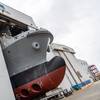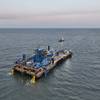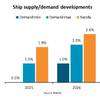China: Capacity Soars, but is Quality, Finance Keeping Pace?
Despite rapidly rising newbuilding prices, it is estimated that higher ship production costs mean few deliveries will make money for their builders this year. Although a prompt VLCC resale might fetch US$105m today, such a vessel would probably have been contracted for little more than $60m when it was ordered in 2002. Shipowners may be making spectacular returns on such deals, but shipyard managers are lucky to be making a profit on such deals and, in the meantime, face higher steel and labor costs.
Frightening new shipbuilding statistics have emerged from China this week. According to the China Association of National Shipbuilding Industry, new tonnage delivered by the country’s shipyards this year is expected to top 8m dwt, up from just over 6m dwt last year. In the first six months of 2004, deliveries totalled 4.1m dwt whilst builders chalked up nearly 10m dwt of new contracts, almost a fifth of the world total.
China’s growing strength in the ship construction market further enforces the swing away from new construction in Europe. And, although some European yards have notched up some notable contracts recently, the vast majority of new orders are being won in the east. The crisis facing some European yards has been thrust into the spotlight this week as the Spanish authorities announced new plans for the segregation of the country’s shipyards. The government plans to split military and merchant ship construction, much to the irritation of shipyard workers, some of whom took to the streets in violent protest.
Although Brussels has insisted that state-owned shipbuilder Izar should repay illegal subsidies, it has indicated that it does not want to see an end to Spanish shipbuilding and that there could be some flexibility on the repayment terms. Meanwhile Izar’s owner, Sepi, has drafted a survival strategy for the country’s shipbuilding facilities which appears to exclude certain facilities. Spanish shipbuilding unions, which believe that shipbuilding should remain under state control, are up in the arms that some yards are unlikely to survive unless private capital can be sourced. Meanwhile new global rules on fair shipbuilding pricing practices are expected to be drafted and agreed by the end of next year. Most of the text, which will ban subsidies and other anti-competitive shipbuilding support, is likely to be ready by the end of this year but, according to reports, the full text is unlikely to be ready before the middle of next year. Further discussions will then take place with a final agreement anticipated by the year end. Although the US is conspicuous by its absence from the special negotiating group, set up under OECD directions, the vast majority of the world’s shipbuilders, including the Chinese, are represented at the ongoing talks.













